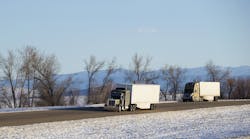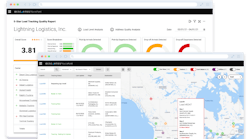The presence of advanced driver assistance systems (ADAS) and collision mitigation technology on commercial vehicles is nothing new to the industry. After all, some Class 8 vehicles now have as many as 25 or more computers, all of which come with their own systems and sensors. But especially in the case of collision mitigation technology, can electronics keep up with the rapidly changing weather that comes with winter conditions?
The Insurance Institute for Highway Safety found that automatic emergency braking (AEB) systems can eliminate 42% of crashes in tractor-trailer collisions, statistics that are supported by the Federal Motor Carrier Safety Administration’s (FMCSA) work that suggested if AEB systems were regularly implemented in commercial vehicles, they could prevent 11,499 crashes.
However, it must be noted that neither of these studies explicitly studied the impact of slick road conditions in regard to the effect AEB or ADAS systems have in mitigating collisions. But Bendix Commercial Vehicle Systems recently ran several technology demonstrations to help drivers understand what to expect from their collision mitigation systems in winter weather.
See also: Safe trucking with Old Man Winter
“During our ride-and-drive safety technology demonstrations, two questions frequently pop up,” said Fred Andersky, Bendix director of demos, sales, and service training. “The first is, ‘What can I expect from collision mitigation on a slick road?’ and the second is, ‘Could an automatic brake application cause me to lose control?’ Conveniently, the answers are found in the inclusion of full-stability technology as a building block of collision mitigation.”
How commercial vehicle collision technology works in adverse weather
Some of these systems focus more on full-stability control, which is required on most new Classes 7 and 8 air-braked tractors in the U.S. Others, such as Bendix’s Electronic Stability Program (ESP) focuses more in mitigating rollovers, helping when a driver does lose control of their vehicle or assisting when a vehicle experiences loss of traction. However, Andersky emphasized that this doesn’t mean that the driver no longer has control of the vehicle. At best, the technology is merely supplementing the driver’s decisions or alerting them to when particular attention is necessary.
Specifically, collision mitigation systems utilize radar, cameras, and sensors connected to an electronics control unite (ECU) to anticipate imminent collisions, in which case the system may reduce the throttle and apply the brakes while also providing in-cab alerts before intervening. What’s important to understand is that the system will respond consistently regardless of whether road conditions are dry or slick.
“The first thing to understand is that the collision mitigation system must detect the situation ahead, then perform calculations to determine if or when alerts or automatic braking is needed,” said Andy Pilkington, Bendix product group director of ADAS/HAD. “The faster the truck approaches the forward vehicle (whether it is stationary or moving), the more difficult it is to detect and the less time the system has to react.”
Ultimately, this means that while collision mitigation systems never take control from the hands of the driver, that means the driver still needs to be active and present during winter driving, as the vehicle automatically slowing itself may still require the driver to swerve to avoid a crash.
See also: Research paves the way for ADAS in trucking
“Specifically, sometimes there is not enough time or friction with the road surface to provide any alert or sufficient braking force to mitigate impact with the forward vehicle,” continued Pilkington. “In other situations, the truck can partially decelerate and may still impact the forward vehicle with a lesser speed. And in yet another set of circumstances, there is sufficient friction with the road surface and time to detect the situation to prevent impact altogether. The situation matters!”
How winter weather impacts truck control
This is especially true in winter conditions when the friction of truck tires on hard-packed snow or ice is reduced by 87% than on dry roads, the company reported. That means a truck that would normally come to a halt in 335 ft. on dry pavement might need as much as 965 ft. on packed snow and 1,625 ft. on ice.
“This is the perfect illustration of why driver alerts are so critical,” Pilkington said. “Giving the drivers time to react before a system intervenes helps capitalize on their abilities to see farther and also to steer–something most of today’s collision mitigation technologies don’t do.”
Overall, Bendix stated that drivers are no more likely to lose control due to their AEBs than they are with manual braking; in fact, having electronic stability controls can only help a driver’s reaction time with assisted slowing and alerts.
“Ultimately, safe, alert drivers are the single most important factor to help mitigate collisions on slick roads,” concluded Andersky. “They have advantages over technology – sight and steering – and they’re trained to recognize the crucial factors in increasing following distance to create reaction time when the weather gets bad.”




